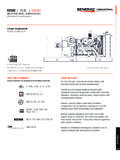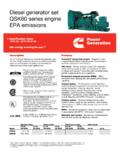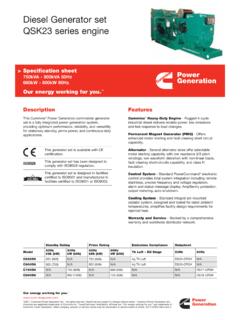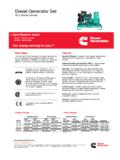Transcription of Engine Cooling for Emergenc Power Generation …
1 ASHRAE JOURNAL APRIL 201654 Stephen W. DudaStephen W. Duda, , is senior mechanical engineer at Ross & Baruzzini, Inc. in St. ENGINEER S NOTEBOOKIn my last column for the Engineer s Notebook series,1 I pointed out that building system design engineers who regularly design comfort heating and Cooling systems may be called upon only occasionally to design and specify mechanical systems related to emergency Power Generation . There may be some facets of Engine genera-tor system design with which an experienced HVAC engineer will not necessarily be familiar. That previous column dealt with the fuel oil systems; this column will attempt to tackle Engine Cooling and generator room STEPHEN W.
2 DUDA, , BEAP, HBDP, HFDP, FELLOW ASHRAE Engine Cooling for Emergency Power Generation SystemsThis column is intended to apply where an Engine generator is installed indoors. Complete packaged Engine generator systems are commercially available in an assembled Engine and generator, with factory pre-packaged exhaust system, radiator, louvers, and acces-sories in a weather-proof housing ready to plug and play. This column is not intended to apply to that type of product. Local RadiatorsThe typical diesel Engine applied in emergency Power Generation is liquid-cooled, just like a diesel Engine in an over-the-road truck. And just like the big rig, the Engine s jacket water is cooled in a water-to-air heat exchanger called a radiator.
3 The radiator for an Engine generator can either be unit-mounted, or remotely simplest radiator option in most cases is a local factory-mounted radiator. The radiator s Cooling fan is typically mechanically connected to the drive shaft, so no external Power source is needed, and the jacket water is usually pre-piped to and from the Engine and radiator. Controls are extremely simple if the Engine is cranking, the radiator fan is rotating. The only field design required for the radiator is a source of intake or makeup air, and a duct enclosure from the radiator discharge to the building exterior. The primary disad-vantage of the unit-mounted radiator is that, on large units, the airflow rate of the radiator s Cooling fan can be exceptionally high a difficult hurdle to overcome if the Engine -generator package is to be located remote from a ready path to RadiatorsFor very large radiators, or for Engine -generator pack-ages located where ample access to outdoor air is not available, remote radiators may be needed.
4 Remote radiators can provide flexibility in terms of location, with the most common choices being on the building roof or on grade in a secure enclosure. Locating the radiator remotely has the disadvantage of requiring field jacket-water piping and often one or more jacket-water circulating generator packages with a unit-mounted radiator include factory-installed jacket water circulat-ing pumps. Those pumps can still be provided even on This article was published in ASHRAE Journal, April 2016. Copyright 2016 ASHRAE. Posted at This article may not be copied and/or distributed electronically or in paper form without permission of ASHRAE. For more information about ASHRAE Journal, visit 2016 ASHRAE JOURNAL55 COLUMN ENGINEER S NOTEBOOK packages with remote radiators, but their size and pres-sure capacity limits the distance to the radiator.
5 Often, the engineer will need to specify separate external pumps, with a separate Power connection. Since we are discussing emergency Power Generation , these external jacket water pumps and remote radiator fans will obvi-ously also require a source of emergency Power . Remind the electrical engineer to oversize the Generation capac-ity because of the Power that will need to be diverted from emergency use to Power the jacket water pumps and remote radiator Tip: Today s engines often require two sepa-rate piping circuits for jacket Cooling water one each for the Engine and turbocharger and the radiators typically are coiled with the two circuits intertwined. A total of four pipe lines are required, two supply and two return, and cannot be combined due to their differing temperatures.
6 Failure to recognize this may result in costly last-minute design changes and a lesson learned the hard Tip: Selecting jacket water circulating pumps is not unlike selecting pumps for HVAC chilled or heat-ing water. However, the jacket water is typically a glycol solution (in locations where winter temperatures can be expected to fall below freezing), and the operating temperatures are higher than most heating water selec-tions, so density, specific heat, and other fluid proper-ties must be properly applied. Do not use the common properties of water without appropriate , radiator pressure ratings need to be reviewed. A typical radiator may be designed for close coupling with relatively low pressure ratings.
7 If located far away from the Engine , the pumping pressure requirements can exceed the radiator pressure rating. This may require addition of a secondary loop with an isolation heat Exhaust Mufflers, Piping and AccessoriesThe Engine exhaust must be ducted outdoors and discharged at an acceptable location. Common com-ponents of the exhaust system are flexible connectors, mufflers, anchors and guides, an end-cap or other termination, and pressure relief. Particulate filters can also be required in some pollution control districts. The piping itself can be standard-weight welded steel pipe. Insulation, typically Calcium Silicate, on that pipe is often needed for safety of personnel who may be working nearby,2 as exhaust temperatures can approach 1,000 F (540 C).
8 The muffler is most often sized and selected by the Engine generator manufacturer, and either critical-grade or super-critical grade are most often chosen. Physical styles include an inline cylindrical type, or space/layout considerations may indicate use of a pancake style that is wider but flatter, with bottom-in and side-out arrangement. Just as with the pipe, it may require insulation for safety reasons, or factory-insulated models may be specified. Engine generator manufacturers also frequently offer a pipe expansion fitting for use at the generator exhaust manifold connec-tion, and a weather cap of some sort for the termination point. Some engineers add a spring-loaded pressure relief device in the Engine exhaust piping, because they believe it is required by NFPA 37-20103 Paragraph Exhaust systems shall be designed and constructed to withstand forces caused by the ignition of unburned fuel or shall have provisions to relieve those forces without damaging the exhaust system.
9 However, the explana-tory appendix material at the end of NFPA 37 Item reads Normally, this provision is met by the built-in strength of the system. Building operators find the pressure relief devices to be a tremendous nuisance and the component manufacturers this author spoke to agree that the system is designed with sufficient robust-ness so as to avoid the pressure relief fittings. The length of the exhaust run may be just a few yards/meters if located near an exterior wall or roof; but may be a great distance away if, for example, the exhaust must route vertically from a basement through a tall building. If lengthy, the engineer must consider the maximum exhaust static pressure avail-able as published by the Engine manufacturer often on the order of 27-in.
10 ( kPa). Long runs also require consideration for additional expansion fit-tings as the piping will be subject to cycles between ambient temperature and the nearly 1,000 F (540 C) exhaust temperature. Supports, anchors, and guides need to be selected to allow for expansion and Tip: Do not manifold the exhaust piping from multiple Engine sets. Instead, route each Engine s exhaust pipe to the outdoors separately. If manifolded, the online machine will backfeed exhaust to an offline ASHRAE JOURNAL APRIL 201656engine, causing portions such as the turbocharger to freewheel without the oiling system Tip: In lieu of steel piping with field-applied insulation and applied expansion fittings, many engi-neers find it more convenient and cost-effective to specify a pre-engineered listed double-wall exhaust flue system offered by many of the same manufacturers that sell boiler exhaust flues.





